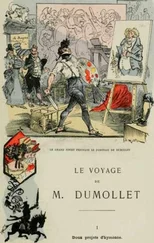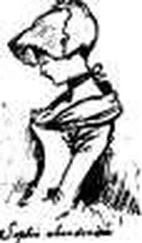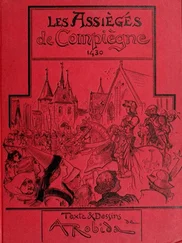Albert Robida - Yester-year; ten centuries of toilette from the French of A. Robida
Здесь есть возможность читать онлайн «Albert Robida - Yester-year; ten centuries of toilette from the French of A. Robida» весь текст электронной книги совершенно бесплатно (целиком полную версию без сокращений). В некоторых случаях можно слушать аудио, скачать через торрент в формате fb2 и присутствует краткое содержание. Жанр: Старинная литература, на английском языке. Описание произведения, (предисловие) а так же отзывы посетителей доступны на портале библиотеки ЛибКат.
- Название:Yester-year; ten centuries of toilette from the French of A. Robida
- Автор:
- Жанр:
- Год:неизвестен
- ISBN:нет данных
- Рейтинг книги:4 / 5. Голосов: 1
-
Избранное:Добавить в избранное
- Отзывы:
-
Ваша оценка:
- 80
- 1
- 2
- 3
- 4
- 5
Yester-year; ten centuries of toilette from the French of A. Robida: краткое содержание, описание и аннотация
Предлагаем к чтению аннотацию, описание, краткое содержание или предисловие (зависит от того, что написал сам автор книги «Yester-year; ten centuries of toilette from the French of A. Robida»). Если вы не нашли необходимую информацию о книге — напишите в комментариях, мы постараемся отыскать её.
Yester-year; ten centuries of toilette from the French of A. Robida — читать онлайн бесплатно полную книгу (весь текст) целиком
Ниже представлен текст книги, разбитый по страницам. Система сохранения места последней прочитанной страницы, позволяет с удобством читать онлайн бесплатно книгу «Yester-year; ten centuries of toilette from the French of A. Robida», без необходимости каждый раз заново искать на чём Вы остановились. Поставьте закладку, и сможете в любой момент перейти на страницу, на которой закончили чтение.
Интервал:
Закладка:
Under the gown, which continued to be worn loose and flowing for a long time, à la Watteau, the 'body' or corset strictly confined the bust, the satin bodice was pointed and the waist very long; as it was low-necked, a ' breast-front ' of lace and ribbons protected the chest from cold.
Mantles were adapted to the season or the temperature ; that is to say, they were either pi'etty little mantillas^ which just covered the shoulders, with a light frilled silk or satin hood, or cloaks covering the entire figure down to the heels; the hood was held out by a hoop of brass wire around the head. From 1725 to 1770 or 75, the fashion in gowns retained the same lines, and almost the same general arrangements, the swelling skirts, the clouds of lace, and the bunches of ribbon. The best period of the mode of the eighteenth century, that in which the Louis Quinze costume was at its highest point of elegance, was between 1750 and 1770, the middle period between the exaggeration of ^ Cofjuehichoiis (obsolete).
the Regency time and that of Louis XVI., which was no less unreasonable.
During those years her beautiful, astute, artistic, and encroaching majesty, Madame de Pompadour, reigned. If we would summon up a vision of that radiant period and realize its charm, we have but to quote the names

A little milliuer.
of Boucher, Baudoin, La Tour, Lancret, Pater, Elsen, Gravelot, Saint-Aubin, and the whole galaxy of fops and exquisites, scented and silly indeed, but also delightfully polished and graceful.
There was corruption under the perfume of roses, it is true, and it will not do to scratch that vernis-Martin society too deeply; there was so much ' laisser-aller ' and * laisser-faire ' everywhere, and it was so difficult to be scandalized by anything whatsoever.
After Pompadour, Louis XV. fell very low, even down to Dubarry ; he had his seraglio at the ' Pare an Cerfs,' like the Grand Turk, his daughters. Loque, Chiffe, and Graille, drank brandy, and smoke pipes borrowed from the guard-room. Nobles and financiers had their " Follies," where they received great ladies or opera-girls, and marchionesses sat at table with Gardes-Françaises at Ramponneau's.
How skilfully this eighteenth century arranged its scenery and decorations, how carefully it laid out a pleasant and charming life for itself, never thinking or caring about that which awaited it in the fifth act of its fairy play ! Its most exquisite personification is in Latour's great pastel, the portrait of Mme, de Pompadour, in a so-called ' négligé d'intérieur,' which is a poem in satin, ribbons, and lace.
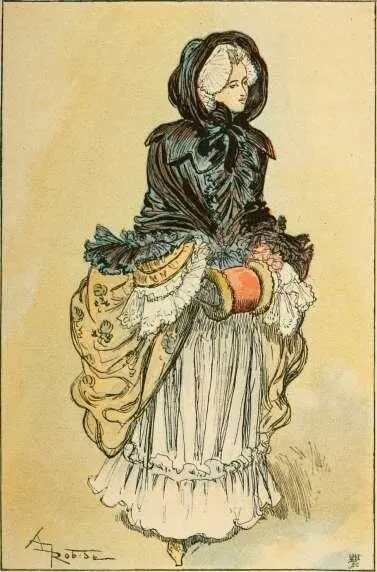
PARISIENNE SOUS LOUIS XV.
Woman reigns and rules, the sceptre of her sovereignty is the fan. For a long time
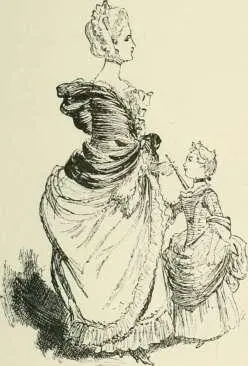
"Walking-dress.
the fan had been in vise ; in the middle ages it was called ' Esmouchoir'; there had been square ftms, feather-fans attached by a jewelled chain to the girdles of noble ladies in tlie sixteen til century, and the folded fan, brought from Italy by Catherine de Médicis, and adopted by Henri III.
From the time of Louis XIV., the fan had been indispensable to the toilet of women, but its great period, in which the finest specimens were produced, was the eighteenth century.
The Louis Quinze fans, with their ivory and mother-of-pearl mounts, marvellously cut and worked, and their exquisite paintings by Watteau, Lancret, and others, were the sceptres of a powdered, effeminate, and affected society ; wielded by the hands of favourites, the fan swayed the monarch, his ministers and generals, the arts, letters, politics, and the world.
The engraving by Gabriel de Saint-Aubin, entitled ' Le Bal Paré,' shows us the fine ladies of that time in full dress ; still the Watteau folds, the loose gowns open over the bodice and under-skirt, caught in at the waist by ribbons, and raised high at the sides on the swell of the panier, still the profusion of fluttering trimmings, borders of fur or folded bands, and flounces of satin or lace.
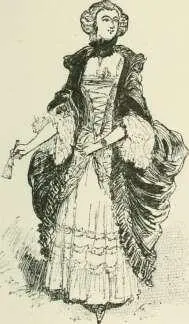
After (i. de Saiut-Aubin.
Head-dresses began to mount up again, but were still elegant and becoming, the powdered hair was raised over the well-displayed fore-ead, and arranged in bows and rolls mingled with loops of ribbon, feathers, and pearls.
Let us glance at those same ladies at the Promenade de Longchamps, in superb painted and gilded coaches, for that was the carriage-building time of fairy tale, and compared with its productions, the most sumptuous vehicles of our prosaic epoch, however well " tui'ned out," varnished, and blazoned, would look like hearses.
In these imposing carriages, driven by stately coachmen, bewigged, belaced, and befrogged, with tall footmen in showy liveries hanging on behind, what a display there was of luxurious dress, lace, feathers, ribbons, diamonds and pearls !
Grooms rode at the carriage doors, running-footmen pushed through the crowd of equipages and equestrians of both sexes. In the crowd assembled on both sides of the road to admire the fashionable beauties, and fashion itself, amid the chatter of casual meetings, and conversations with young nobles, dandies, and
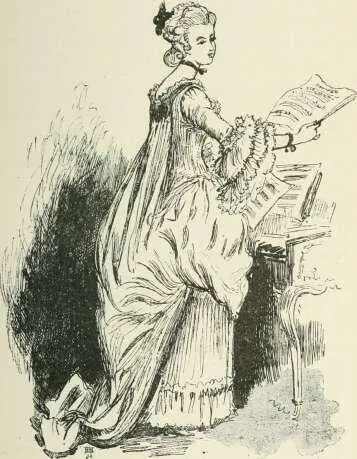
After the younger Moreau.
roués, the ' inaniuise/ and the ' présidente/ the lady of quality and tlie lady of ' finance,' the opera-girl, the dancer, the actress of the hour, who was turning the empty heads of the play-going gallants who vied with each other for her favour, and the courtesan who might next week be proclaimed ' Queen by the left hand/ elbowed each other j)romiscuously. When winter came, these fine ladies would forsake their coaches, and that other delightful creation of a charming age, the Sedan chair {chaise à porteurs), painted in vernis-Martin with scenes of gallantry or pastoral life in the styles of Boucher and Watteau ; they would lay aside laces and ribbons, wrap themselves up in furs, and be off, their little pink noses just peeping out of sable or blue fox, and their hands hidden in muffs as big as drums, to drive on the snow in splendid sleighs of extraordinary shapes, brilliantly painted, ornamented with carved and gilded figures, and elegant and fanciful beyond description.
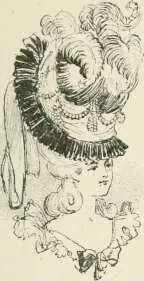
Large Louis Suizu bat.
IX.
EIGHTEENTH CENTURY— LOUIS XVI.
Enormous head-dresses—The pouf 'au sentiment' —Parks, kitchen-gardens, and landscapes with figures, worn on the head—The ' Belle-Poule ' head-dress — Patches — Country fashions—' Negligent ' gowns — Fashionable colours — Eiding-habits—English fashions—The bourgeoises.
The century was growing old ; the age of exquisite coquetry, of powdered and perfumed elegance, was becoming stricken in years, and waxing weary of its butterfly air and its tinsel decoration.
Taste had grown tired and was indolent, novelty Avas no longer sought for, fashion remained stationary for a long time, or moved in a circle only.
The Louis Quinze style was now out of date, like that of Louis Quatorze ; ' rococo ' was pronounced to be 'jDerruque' and 'vieux jeu' ; but let us wait a bit, fasliion is about to spread its wings suddenly and to risk everything, even a tumble into the preposterous; but surely it may allow itself to do this three or four times in a century, after all ?
Читать дальшеИнтервал:
Закладка:
Похожие книги на «Yester-year; ten centuries of toilette from the French of A. Robida»
Представляем Вашему вниманию похожие книги на «Yester-year; ten centuries of toilette from the French of A. Robida» списком для выбора. Мы отобрали схожую по названию и смыслу литературу в надежде предоставить читателям больше вариантов отыскать новые, интересные, ещё непрочитанные произведения.
Обсуждение, отзывы о книге «Yester-year; ten centuries of toilette from the French of A. Robida» и просто собственные мнения читателей. Оставьте ваши комментарии, напишите, что Вы думаете о произведении, его смысле или главных героях. Укажите что конкретно понравилось, а что нет, и почему Вы так считаете.

